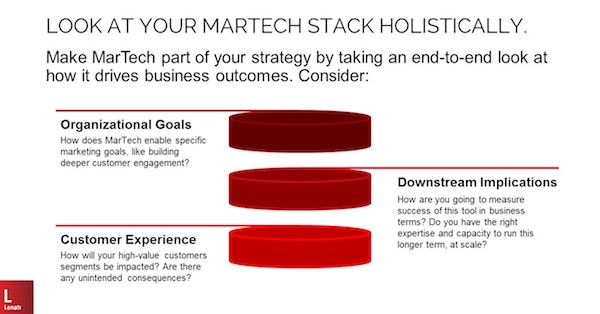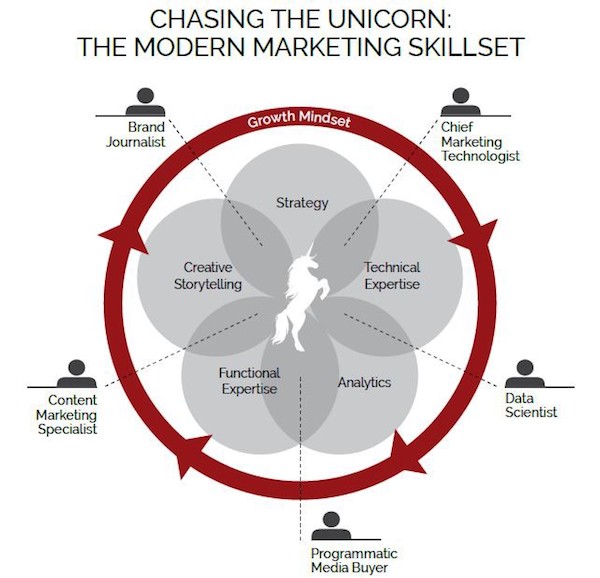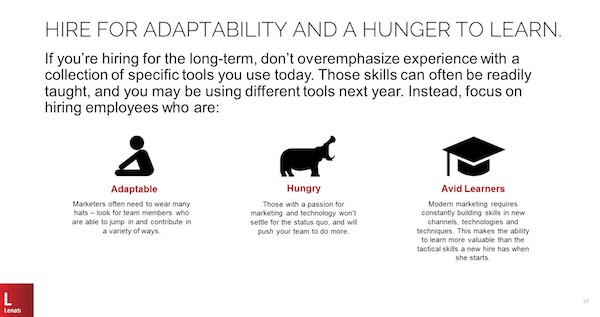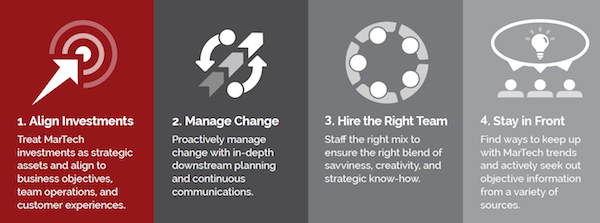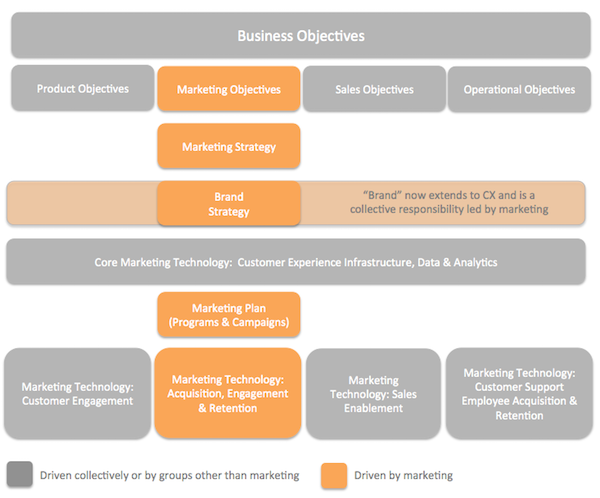This article is a guest post by Liam O’Connor of Lenati. It was entered into The Hackies essay contest for the upcoming MarTech conference. Like it? You can register your vote in the contest by sharing it on social media, especially LinkedIn, Facebook, and Twitter.
For marketing executives and their teams, building an effective marketing technology stack is a daunting prospect. With marketing technology growing as a portion of total marketing budget (27% on average according to Gartner), marketers face two growing challenges: increased scrutiny from C-suite partners on the value of martec investments and the need to get more out of the current marketing technology stack.
Marketing executives are having to consider innovation, scalability, and a clear balance between short-term revenue impact vs long-term competitive advantage.
The “shiny penny” approach (focus all your attention on the latest and greatest) or “head in the sand” approach (avoid making decisions until absolutely necessary) are no longer viable. Ultimately, we need to be intentional in our martech approach.
I’ll touch on three practical approaches that marketing leaders and their teams take to MarTech strategy:
- How do we decide which martech bets to make?
- How do we recruit, hire, and nurture the right team?
- How do we foster innovation and stay in front of what’s next?
1. How do we decide which martech bets to make? Strategy shapes the decision-making process
One of the biggest recent shifts is treating your martech stack as a strategic capability and asset, rather than a set of tactical tools or “shadow IT.” When building your stack, an effective strategy includes several considerations:
- The company’s business goals. Once you are beyond the core platforms (marketing automation, CRM, CMS, etc.), additional tools and capabilities should be laser-focused on the business objectives they will support. For example: Is the goal to raise awareness of a new product category? Build deeper engagement with a key audience? Improve advocacy and retention among existing customers? We talked with one marketing team for a high-growth SaaS company that focused on three primary goals: (1) Lowering cost of acquisition, (2) accelerating deal volume/value, and (3) reducing churn — every martech investment they made was evaluated against these three business outcomes.
- Downstream impact. Companies often pilot and launch a host of new tools without thinking through the downstream implications. There are a lot of considerations here, but a few major ones are: Can we measure business impact? Do we have the right expertise and capacity to manage and run the tool after the “pilot?” How will the outputs of this tool be integrated into our current marketing workflows and systems?
- The customer experience for high-value segments. Marketers should always perform a gut-check to ensure any changes will not disrupt the customer experience for high-value segments. Too many times, tools launched in siloes end up having “unintended consequences” on customers. Specifically, marketers should ensure they have customer experience KPIs and voice of the customer inputs integrated within their evaluation plan for new technologies.
Treat Your MarTech Stack Like an Investment Portfolio
Many marketing executives are striking a balance between innovation and scale by treating their stack as a portfolio of investments. Rather than having one vetting process for all solutions, they vary their approaches by solution and purpose.
Two examples of this portfolio method:
- One tech company looked at a 70-20-10 ratio of invested dollars against: core platforms (70%), extensions of those platforms through point solutions (20%), and forward-looking innovation pilots (10%).
- A consumer products company similarly bucketed technologies into enterprise platforms, tactical tools, and innovation — and they had a different decision process and time horizon for each.
Always Design for Change
With the marketing technology landscape in constant flux, it is incredibly challenging for even the best industry analysts — let alone marketers with full-time day jobs — to predict which vendors to rely on in five years. That’s why marketers need to prepare for the unknown.
A smart marketer will always have an exit strategy to maintain flexibility in her martech stack should the unforeseen happen. Common questions to ask include:
- What are the financial viability and long-term prospects for the vendor?
- How flexible are vendor contracts?
- Who owns the data flowing through each solution?
- How easily could each solution be removed or replaced?
- If we removed or replaced any solutions, what would be the impacts on other components in the martech stack?
Putting a contingency plan in place will help companies remain agile and shift as the tides of change accelerate.
2. How do we recruit and hire for the right team? Staff the right mix of skills
As modern marketing become more complex and the collection of necessary skills has grown too varied to exist in any individual, executives are realizing that chasing the one perfect hire, marketing’s “golden unicorn,” is no longer realistic. Instead, marketing executives need to ensure that they staff the right mix of skills across the entire team and then build the structure and culture needed to unlock their potential.
Hiring managers have focused on staffing tech-savvy and analytical marketers. Often defined as the “modern marketer,” these hires are growth focused, technically knowledgeable and digitally native. Often these folks are very open to experimentation and hone their marketing expertise through a “learn by doing” approach.
However, many marketing executives we work with are noticing that their hiring pendulums have swung too far, and foundational strategic marketing insights are getting lost at the executional level.
Hiring a Tech-Savvy Marketer
The growing need for a tech-savvy marketer is not a new concept. But what does it really mean to be tech savvy? As the pace of marketing technology change increases, it’s no surprise that the true skillset needed is not only the knowledge and experience the person brings in on day one, but also the ability to learn and adapt quickly to stay ahead of any new wave of change. When interviewing, executives need to uncover a person’s passion for learning and her ability to adapt within an ever-changing technology-centric environment.
Strategy and the Art of Storytelling is Still Crucial
Going back 10 years, traditional marketers were trained to follow proven strategic frameworks where campaigns were crafted from positioning statements, benefits, and proof points. Then, gifted marketers would layer on the creativity we often associate with the Mad Men generation, and craft a story that captures attention while driving desired business objectives.
These skills are still critical, especially in today’s world of message oversaturation. Marketers need to grab people’s attention and evoke emotion to break through the noise and see results, especially if they want to win at earned media. Without a compelling story rooted in customer insight, any digital marketing tactic will fall flat.
Organize Teams for Information Sharing
Even in the most collaborative cultures, teams can benefit from more formalized information sharing structures to ensure critical learnings are shared quickly and individual strengths are optimized. Since every company’s skills, strategy, and structure are unique, there is no one-size-fits-all model. Successful approaches we’ve seen include a marketing team that does a weekly “step-back” to deep dive with structured knowledge sharing on a particular technology, customer segment, or marketing goal.
3. How do we drive innovation and stay in front of what’s next? With a dose of creativity and agility
When in the market for a new technology, marketing executives often need to get smart quickly in a new category (such as predictive analytics). Relying on analysts and vendors alone may lend to biased framing of the business issue, which of course supports their offerings.
A few interesting approaches include:
- Conduct peer exchanges with similar, non-competitive companies who are often eager to share what has worked for them and willing to go deep in a face-to-face forum.
- Form informal partnerships with VCs and others in the start-up community to keep a pulse on new investment areas and capabilities in the market.
- Go to industry/martech conferences with a couple of focused business questions to solve, and push the team to prioritize those use cases with new approaches to solving them.
And finally, marketing executives can best prepare for the next martech wave of change by engaging the entire marketing organization in the process. Evaluation of particular tools and technologies is often delegated down in the organization. Executives are taking this a step further.
For example, one CMO we spoke with effectively empowers individuals on her team to own functional areas and be on top of MarTech developments within their area. The functional leads regularly present back to the team on key developments and new capabilities, while driving vendor evaluation, selection, and their own budget to make decisions.
Companies are recognizing the impact that the right martech investments can have in driving their business forward. With greater investment levels, growing complexity, and higher expectations from leadership, marketing executives can no longer take a cobbled approach to their technology stacks. Instead, they must treat marketing technology as a strategic capability and asset.
What did you think of this article as an entry in The Hackies essay contest for the upcoming MarTech conference? If you liked it, you can register your vote in the contest by sharing it on LinkedIn, Facebook, and Twitter.
Have a marketing/technology/management “hack” that you want to share with the world? Consider entering The Hackies yourself — we’d love to learn from your experience and insight!

